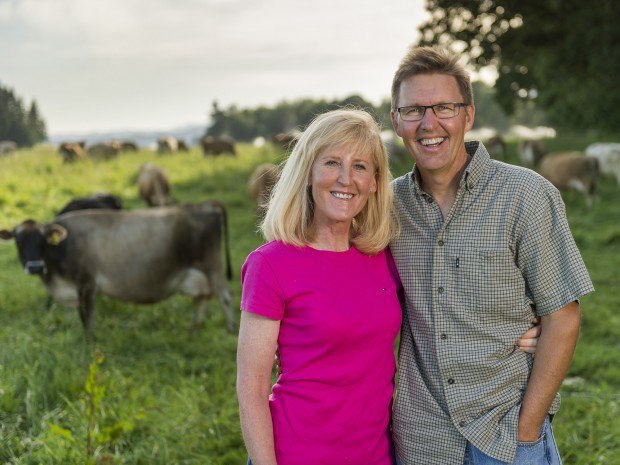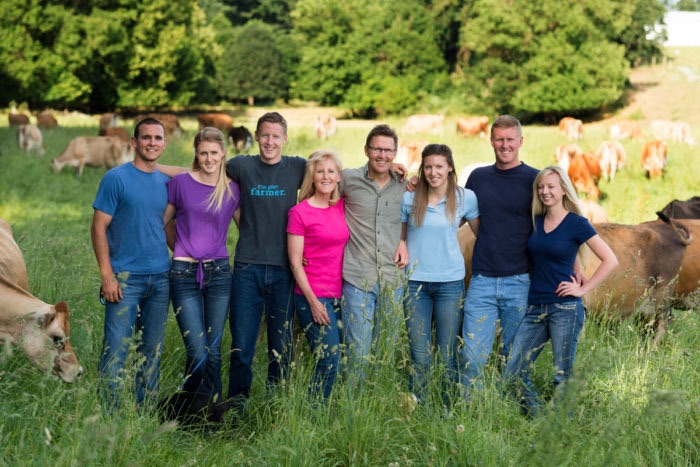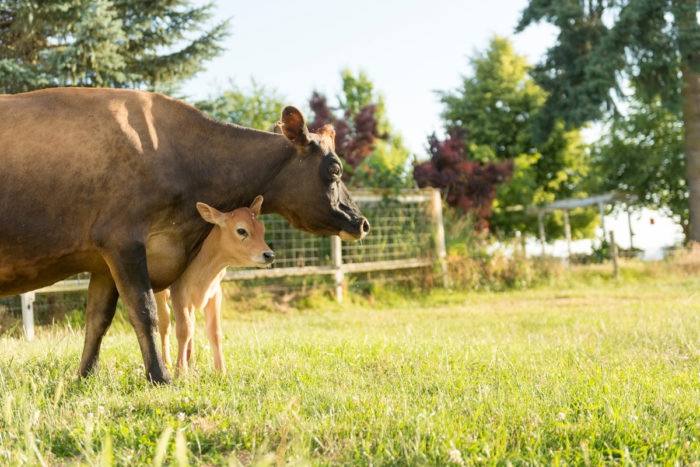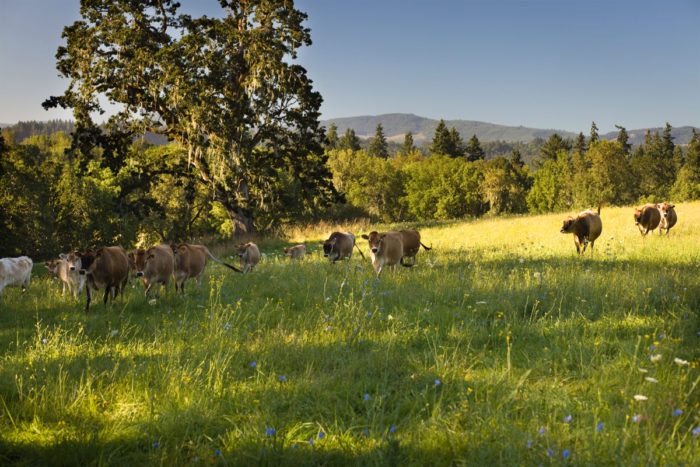
An Oregon Dairyman Reclaims the Pasture
Meet Jon Bansen, a pasture-based dairyman in Oregon's Willamette Valley, in this profile I wrote for Civil Eats' Farmer of the Month series.
Fourth-generation farmer Jon Bansen
translates complex grazing production systems
into common-sense farm wisdom.
In the U.S., the dairy industry is a tough business for organic and conventional producers alike, with plunging prices and changing consumer demand leading to a spate of farm shutdowns and even farmer suicides. And in Oregon, where dairy is big business—accounting for 10 percent of the state’s agriculture income in 2016—the story is much the same.
 But Jon Bansen, who has farmed since 1991 at Double J Jerseys, an organic dairy farm in Monmouth, Oregon, has throughout his career bucked conventional wisdom and demonstrated the promise of his practices. Now he’s convincing others to follow suit.
But Jon Bansen, who has farmed since 1991 at Double J Jerseys, an organic dairy farm in Monmouth, Oregon, has throughout his career bucked conventional wisdom and demonstrated the promise of his practices. Now he’s convincing others to follow suit.
Bansen and his wife Juli bought their farm in 1991 and named it Double J Jerseys, then earned organic certification in 2000. In 2017, he switched to full-time grass feed for his herd of 200 cows and 150 young female cows, called heifers. He convinced his brother Bob, who owns a dairy in Yamhill, to convert to organic. His brother Pete followed suit soon after. (“He’s a slow learner, that’s all I can say,” Bansen joked.)
He’s someone who prefers to lead by example, which has earned him the respect of a broad range of the region’s farmers and ranchers, as well as its agricultural agencies and nonprofits.
“Jon is an articulate spokesperson for organic dairy in Oregon and beyond,” said Chris Schreiner, executive director of Oregon Tilth, an organic certifying organization. “His passion for organic dairy and pasture-based systems is contagious, and he does a great job of translating complex grazing production systems into common-sense farmer wisdom. His personal experience … is a compelling case for other dairy farmers to consider.”
George Siemon, one of the founders of Organic Valley, the dairy co-operative for which Bansen produces 100 percent grass-fed milk under Organic Valley’s “Grassmilk” brand, believes the switch to 100 percent grass is a direction that Bansen has been moving in all along.
“He’s just refined and refined and refined his organic methods,” said Siemon, admitting that Bansen is one of his favorite farmers. “He’s transformed his whole farm. It’s a great case when the marketplace is rewarding him for getting better and better at what he does and what he likes to do.”
Deep Roots in Dairy Farming
Dairy farming is baked into Bansen’s DNA, with roots tracing all the way back to his great-grandfather, who emigrated from Denmark in the late 1800s, settling in a community of Danes in Northern California. His grandfather followed in the early 1900s, hiring out his milking skills to other farmers until he saved enough to buy his own small farm near the bucolic coastal town of Ferndale in Humboldt County.
 Bansen was about 10 years old when his father and their family left the home farm to strike out on their own in Oregon’s Willamette Valley. They bought land in the tiny, blink-and-you’ll-miss-it town of Yamhill, about an hour southwest of Portland.
Bansen was about 10 years old when his father and their family left the home farm to strike out on their own in Oregon’s Willamette Valley. They bought land in the tiny, blink-and-you’ll-miss-it town of Yamhill, about an hour southwest of Portland.
A typical farm kid, Bansen and his seven siblings were all expected to help with the chores. “You fed calves before you went to school, and you came home and dinked around the house eating for awhile until you heard Dad’s voice beller at you that it was time to get back to work,” Bansen recalled. “I was a little envious of kids that lived in town and got to ride their bikes on pavement. That sounded pretty sexy to me.”
After studying biology in college in Nebraska and getting married soon after graduating, Bansen and his wife worked on his dad’s Yamhill farm for five years and then began talking about getting a place of their own. They found property not far away outside the sleepy town of Monmouth. It had the nutritionally rich, green pastures Bansen knew were ideal for dairy cows, fed by the coastal mists that drift over the Coast Range from the nearby Pacific Ocean.
One day, a few years after they’d started Double J Jerseys, a man knocked on their door. He said he was from a small organic dairy co-op in Wisconsin that was looking to expand nationally. He wondered if Double J would be interested in transitioning to organic production, mentioning that the co-op could guarantee a stable price for their milk.
It turned out that the stranger was Siemon, a self-described “long-haired hippie” who’d heard about Bansen through word of mouth. “He was reasonably skeptical,” recalls Siemon. “He wanted to make sure it was a valid market before he committed, because it’s such a big commitment to go all the way with organic dairy.”
For his part, Bansen worried that there wasn’t an established agricultural infrastructure to support the transition, not to mention the maintenance of an organic farm. “I was worried about finding enough organic grain,” he said.
On the other hand, however, the young couple needed the money an organic certification might bring. “We had $30,000 to our name and we were more than half a million dollars in debt” from borrowing to start the farm, Bansen said.
After much research and soul-searching, they decided to accept Siemon’s offer and started the transition process. It helped that his cousin Dan had transitioned one of his farms to organic not long before and that generations of his family before him had run pasture-based dairies.
“My grandfather, he was an organic dairy farmer, he just didn’t know what it was called,” Bansen said. “There were no antibiotics, no hormones, no pesticides. You fed your cows in the fields.”
The Organic Learning Curve
During the Bansens’ first organic years, they had to figure out ways to eliminate antibiotics, hormones, and pesticides—all of which Bansen views as “crutches” to deal with management issues.
 To prevent coccidiosis, a condition baby cows develop when they don’t receive enough milk and are forced to live in overcrowded conditions, for example, Bansen fed his calves plenty of milk and made sure they had enough space.
To prevent coccidiosis, a condition baby cows develop when they don’t receive enough milk and are forced to live in overcrowded conditions, for example, Bansen fed his calves plenty of milk and made sure they had enough space.
To prevent cows from contracting mastitis, an infection of the mammary system, he changed the farm’s milking methods.
Another learning curve had to do with figuring out the balance of grain to forage (i.e., edible plants). Originally Bansen fed each of his cows 20 pounds of grain per day, but after switching to organic sources of grain, he was able to reduce that to four or five pounds a day. This switch cut down grain and transportation costs dramatically.
He also had to learn to manage the plants in the fields in order to produce the healthiest grazing material possible. Since the transition to organic, Double J has grown to nearly 600 acres, a combination of pastures for the milking cows, fields for growing the grass and forage he stores for winter, when it’s too cold and wet to keep the animals outdoors.
“It’s not a machine; it’s a constant dance between what you’re planting and growing and the weather patterns and how the cows are reacting to it,” said Bansen. “There’s science involved in it, but it’s more of an art form.”
Read the rest of the article and find out why Bansen made the decision to transition to a grass diet for his cows, and why he's "sick of farmers bitching about the price of milk and [then] going down to Walmart to buy groceries and taking their kids out to McDonald’s. You have no right to bitch about what’s going on in your marketplace if you’re not supporting that same marketplace."